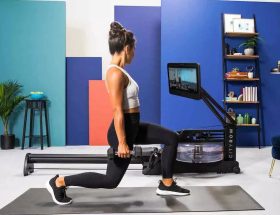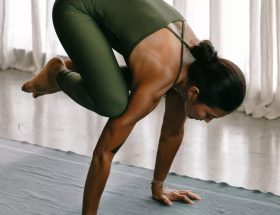Shoulder Taps What They Are and How to Do Them
lthough shoulder taps may appear similar to a plank, they are in fact an exercise all their own. This high-energy, low-impact movement targets your shoulders (of course!), abs, and obliques, and will also engage the lower-back region as the core activates to stabilize the entire body.
As you shift the weight from arm to arm, this exercise will spike your heart rate for a cardio boost, alongside its strengthening benefits. And as a bonus, your wrists and arms will grow stronger over time, making it easier to bear more weight and prop up the body without feeling the strain.
FEATURED VIDEO
Steps To Create The Perfect Bath
Want to learn more? Get all the tips and tricks from the experts below.
MEET THE EXPERT
Cat Kom is CEO and founder of Studio SWEAT onDemand.
Brittany Bowman, CPT, is a personal trainer with DOGPOUND Los Angeles.
What Are Shoulder Taps?
Shoulder taps require you to touch each hand to the opposite shoulder, meaning it’s an active movement. “As you bring your hand to meet the shoulder, you need to hold your body still in a plank position,” says Cat Kom, CEO and founder of Studio SWEAT onDemand. “This makes them a total-body functional exercise that targets multiple groups, including those deep core muscles, and (for posture) they help you practice maintaining a squared position in your hips and shoulders.”
Be mindful to keep the spine in alignment, stabilize through the core, and avoid any rotation of the hips to reap the full benefits of this exercise.
But before attempting shoulder taps, start by getting down to basics. “Shoulder taps are a great way to spice up your core exercises, but should only be performed after confidently mastering a high plank hold,” outlines Brittany Bowman, a personal trainer at DOGPOUND Los Angeles. This is because core strength is required to keep the body from swaying and the hips dipping.
Benefits
In addition to strengthening your arms, shoulders, and core, shoulder taps:
Are Low Impact: Shoulder taps require no jumping or “jolting” movements and are therefore gentler on the body compared with exercises like plank jacks. This makes them a suitable strength-building workout for those avoiding high-impact sports.
Require No Equipment: Perfect for on-the-go workouts, shoulder taps require just your body weight! The only addition you might consider is placing a mat underneath you to provide cushioning for your palms.
Can Improve Posture: Given the elongation of the spine and careful positioning of the body, shoulder taps naturally encourage good posture, which can help you stand taller.
Are Versatile: Throw them into a strength-training, HIIT, or core workout as a complementary exercise. You can also make them easier by executing them on your knees, or up the challenge in an incline position.
Proper Shoulder Tap Form
Follow our step-by-step guide from the experts to learn how to do shoulder taps with proper form.
Lower down onto the mat and move your body into a high plank position, with your hands positioned directly below your shoulders. If a full plank is too difficult, drop down to your knees and/or step your feet hip-width apart for more stability.
While squeezing your core and keeping hips and shoulders square to the ground, press into your right hand as you tap your left palm to your right shoulder.
Switch the tap to your left shoulder with your right palm.
Make sure your shoulders are down and relaxed throughout the movement, and watch out for any swaying of the hips.
Alternate between both sides for around 10–20 seconds (for beginners) and increase the time and/or reps as you gain strength and confidence.
“The goal is to avoid rocking side to side and any kind of twisting motion, so keep checking that your hips are parallel to the ground,” says Bowman.
How to Modify
There are many ways to reduce or add intensity to the exercise, depending on your fitness goals and core strength. “If you want to modify, start by placing your hands on an elevated surface (such as a high box, block, or step) with your knees hip-width apart on the ground,” explains Bowman. “As you get stronger, you can come to the ground on your knees and then eventually onto your hands in a full plank.”
From there, you can challenge your muscles further. “Try holding your hand on the opposite shoulder for 3–5 seconds for added core activation, or, if you are completing your shoulder taps from a high plank, you can try lifting your alternate leg as you tap it out,” adds Kom.
The key to shoulder taps is maintaining stability in the body, so before progressing the movement, practice holding yourself in place as you tap hands to your shoulders. Once you are able to control any sway in the hips, it’s time to progress to the next level.
Safety Considerations
“As with any exercise, make sure you are performing shoulder taps with proper form to avoid injury,” Kom says. Be aware of hips sagging, which adds unwanted pressure to the lower back, or moving too fast during the movement, which causes jolts in the body that take away focus from the core. “Start off slowly—especially if you have weaker wrists or shoulders, as this exercise can add strain to those areas—and work up to higher reps,” says Kom.
If unsure, kick things off with an easier modification to perfect your form first and foremost. For example: “Coming down to your knees and elevating your hands will remove some pressure off the wrists,” suggests Bowman. Or, drop to your knees (with control) after each alternating tap for a moment to rest and reset.
The Final Takeaway
Shoulder taps are designed to target the arms, shoulders, and core (specifically the lower back), don’t require equipment, and are performed by tapping each palm to the opposite shoulder while holding a stable plank position. They can be modified by dropping to your knees or using an elevated surface, such as a block, or made more challenging by elevating the feet. This exercise should be avoided if you suffer from any chronic wrist, shoulder, or lower-back injuries, and make sure your hips are parallel to the floor with your spine aligned during the movement. There should not be any sway in your hips; rather, stabilize through the core to execute shoulder taps with proper control.










